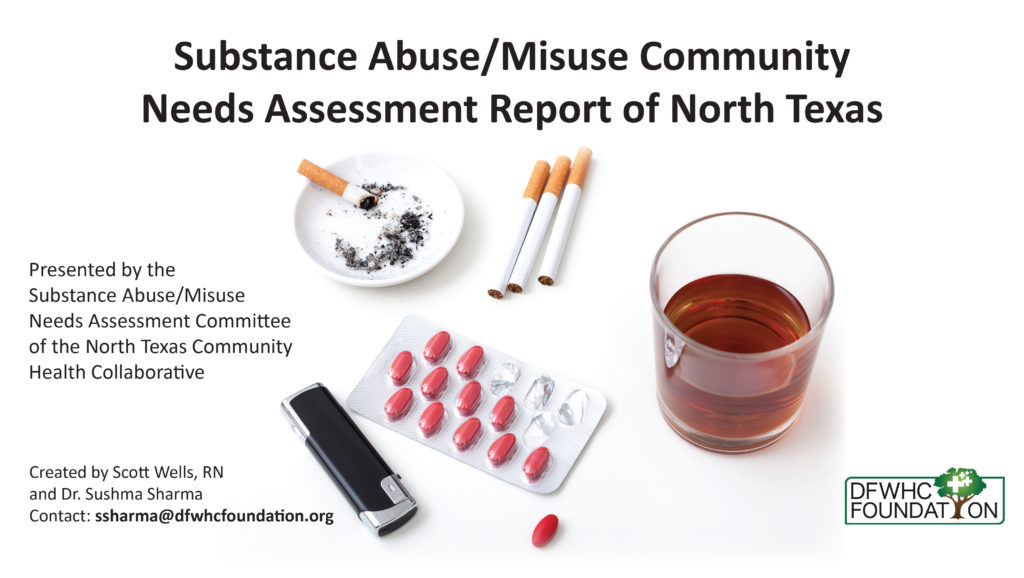
Eleven North Texas counties have deaths attributed to drugs and alcohol higher than state averages, while seven counties have death totals higher than national averages, according to a Substance Abuse/Misuse Community Needs Assessment Report of North Texas released this week.
The 214-page document by the North Texas Community Health Collaborative was a first-of-its-kind study rendering regional diagnoses transparent across 16 counties including the cities of Dallas and Fort Worth. The study offers detailed statistics revealing levels of drug and alcohol misuse, available treatment and the most common types of diagnoses.
Dallas-Fort Worth Hospital Council (DFWHC) Foundation President Kristin Tesmer said the report renders North Texas transparent when deciding what resources are necessary and where they are needed to improve drug and alcohol treatment.
“This is the first time such a detailed study on North Texas alcohol and drug misuses has been produced,” Tesmer said. “We now have a better understanding of areas of need when attempting to improve awareness and strengthen treatment and care. This report allows us to more accurately set strategic goals in North Texas.”
Details of the study covered 2017 data from 16 counties including Collin, Dallas, Denton, Ellis, Erath, Grayson, Hood, Hunt, Johnson, Kaufman, Navarro, Parker, Rockwall, Somervell, Tarrant and Wise.
The report was created by utilizing the DFWHC Foundation’s patient data warehouse including comprehensive hospital-visit information from more than 95 facilities in the region.
Included in the study are annual totals detailing hospital visitors from each county diagnosed with alcohol and drug misuse. Gender, age, race-ethnicity, insurance status and resident zip codes are also detailed.
“Our goal is to promote collaborative efforts within the community,” said Catherine Oliveros, vice president of community health improvement at Texas Health Resources and chair of the Community Health Collaborative. “Substance misuse is a public health challenge that affects many of our communities. With the information available through this report, we have an opportunity to bring communities together to promote data-driven solutions across North Texas.”
According to the Centers for Medicare & Medicaid Services (CMS), more than 15,000 people die from overdoses of prescription opioids on an annual basis in the U.S. And 88,000 people die each year from alcohol-related injuries, the third most common preventable cause of death in the U.S.
Substance misuse also harms the economy, with the National Institute on Drug Abuse estimating U.S. healthcare costs as $232 billion a year and $740 billion overall to include crime and lost work productivity.
Notable details in the report include:
• Ellis, Erath, Grayson, Hood, Hunt, Johnson, Kaufman, Navarro, Parker, Somervell and Wise counties have an overall average of deaths attributed to drugs/alcohol of 965.6 per 100,000 residents, higher than the state average of 699.9 per 100,000;
• Erath, Grayson, Hood, Hunt, Navarro, Somervell and Wise counties have an overall average of deaths attributed to drugs/alcohol of 1051.4 deaths per 100,000 residents, higher than the U.S. average of 863.8 per 100,000;
• Dallas and Tarrant counties had an overall average of deaths attributed to drugs/alcohol of 635.25 deaths per 100,000 residents, well below state and national averages.
“The high numbers in rural counties were troubling,” said Dr. Sushma Sharma, director of population health research at the DFWHC Foundation. “We believe the lack of healthcare providers in those areas were a contributing factor.”
According to the study, over 80 percent of care in North Texas is provided by urban counties due to more healthcare resources, better choices and efficient connectivity.
Due to these dynamics, according to Dr. Sharma, the report reveals significant patient migration in North Texas.
“Inadequate access to health services can subject rural residents to a variety of health risks,” Dr. Sharma said. “This is concerning particularly for vulnerable groups, such as those suffering from substance misuse. Two important goals of this report are to create awareness on the potential health risks of rural residents in addition to the over-crowding of our urban hospitals.”
Additional North Texas characteristics include:
• Nine out of every 1,000 babies born in North Texas suffered from drug toxicity, above CMS’ estimates in the U.S. of 6 out of 1,000;
• Opioids (to include Codeine and Vicodin) were the number one prescribed medication in North Texas with a total of 4,840,563 dispensed prescriptions; Benzodiazepines (Valium and Xanax) were the second most with a total of 1,840,039;
• An average of 33 percent of drug/alcohol misuse patients did not have health insurance, compared to overall Texas averages of 17 percent and U.S. averages of 8.8 percent;
• An average of 76 percent of misuse cases in North Texas were attributed to nicotine addiction.
Coordinated by the DFWHC Foundation, the North Texas Community Health Collaborative represents 10 area hospital systems, behavioral health authorities and community-based organizations with a goal of improving community health services in the region. The Substance Misuse Community Needs Assessment Committee was chaired by Brad Walsh of Parkland Health & Hospital System and Jennifer A. Gilley of Challenge of Tarrant County.
The report can be found here.
For questions, please contact Dr. Sharma at ssharma@dfwhcfoundation.org.
Substance misuse research covers 16 North Texas counties
05/01/2019